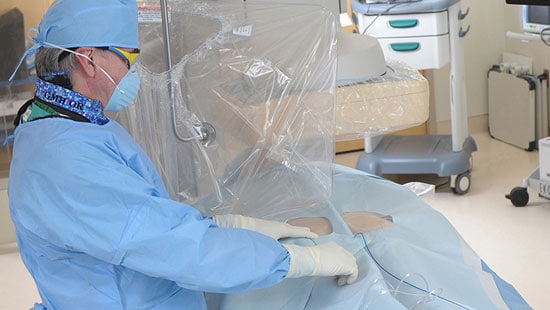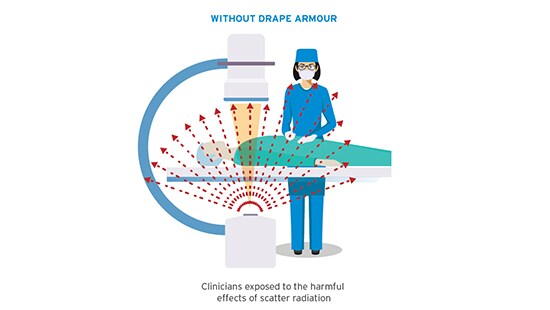
Radiation Protection Drapes
DRAPE ARMOUR™
Product Details
This means you can achieve substantial savings with Drape Armour™ depending upon your individual needs. Complete ratings are included in the charts on the next tab to help you select the Drape Armour™ configuration that's just right for you.
| Material | 60 kVp | 80kVp |
90 kVp |
100 kVp | 120 kVp |
|---|---|---|---|---|---|
| Drape Armour™ LOW - Disk 1 |
85-86% |
82-83% |
80-81% |
77-78% |
72-73% |
| Drape Armour™ LOW - Disk 2 |
85-86% |
82-83% |
80-81% |
77-78% |
72-73% |
DRAPE ARMOUR™ ATTENUATION DATA
| Material | 60 kVp | 80kVp |
90 kVp |
100 kVp | 120 kVp |
|---|---|---|---|---|---|
|
Drape Armour™ |
94-95% |
91-93% |
86-88% |
84-86% |
79-80% |
|
Drape Armour™ |
94-95% |
91-93% |
86-88% |
84-86% |
79-80% |
Material samples for tests are prepared by cutting out small 2 1/2” circular discs of Drape Armour™ material and evaluated by comparing the fractional amounts of radiation transmitted through each sample and varying thickness of lead. The source of radiation is a diagnostic X-ray tube energized by a high frequency generator. The fractional amounts of transmitted radiation are recorded using both film and an ionization chamber. Both the accelerating potential and X-ray beam half-value layers are actively monitored to maintain precise consistency between samples and test sessions. The amount of exposure is adjusted to yield an optical density within the linear response range of the film. Attenuation measurement tests were performed at a range of 60-120 kVp.*
*Test methods performed and descriptions provided by Independent Testing Laboratory (Health Physicists Northwest)
Hidden Dangers of Cumulative Scatter Radiation Exposure
Three Important Factors to Help Reduce Exposure to Scatter Radiation:
1) Time
2) Distance
Keep clinicians as far from the radiation source as possible. The intensity and dose of radiation decrease as distance from the source increases.
3) Shielding
Block as much scatter radiation from the clinician’s skin and vital organs as possible. While many institutions use lead aprons, glasses and gloves to help block radiation, Drape Armour near the radiation source provides critical protection and helps ensure radiation exposure is as low as is reasonably achievable.
Drape Armour by Ecolab Provides Critical Protection for Clinicians

Procedure without Drape Armour™
Clinicians exposed to the harmful effects of scatter radiation.
How Drape Armour™ Works
Drape Armour and Drape Armour LOW free positional shields are designed to protect at the procedure site where scatter radiation is most prevalent. These shields can help to protect surgeons and other members of the clinical staff, and offer substantial attenuation as demonstrated by direct beam studies.


